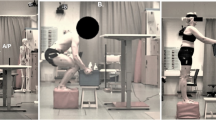Abstract
Background
One of the main ergonomic problems during surgical procedures is the surgeon’s awkward body posture, often accompanied by repetitive movements of the upper extremities, increased muscle activity, and prolonged static head and back postures. In addition, surgeons perform surgery so concentrated that they tend to neglect their posture. These observations suggest the advantage of supporting the surgeon’s body during surgical procedures. This study aimed to design a body support and to test its potential.
Methods
The optimum working condition for a surgeon is a compromise between the spine and arm positions and the level of effort and fatigue experienced performing a procedure. The design vision of the Medisign group has led to the development of an ergonomic body support for surgeons that is suitable for use during both open and minimally invasive procedures. The feasibility of the newly designed ergonomic body support was assessed during seven surgical procedures. Electromyography (EMG) was performed for back and leg muscles using the body support in an experimental setting.
Results
Six of seven participating surgeons indicated that the body support was comfortable, safe, and simple to use. The EMG results show that supporting the body is effective in reducing muscle activity. The average reduction using chest support was 44% for the erector spinae muscle, 20% for the semitendinosus muscle, and 74% for the gastrocnemius muscle. The average muscle reduction using semistanding support was 5% for the erector spinae, 12% for the semitendinosus muscle, and for 50% for the gastrocnemius muscle.
Conclusion
The results of this study imply that supporting the body is an effective way to reduce muscle activity, which over the long term may reduce physical problems and discomfort. Additionally, the product supports the surgeon in his natural posture during both open and minimally invasive procedures and can easily be adapted to the current layout of the operating theater.





Similar content being viewed by others
References
Alarcon A, Berguer R (1996) A comparison of operating room crowding between open and laparoscopic operations. Surg Endosc 10: 916–919
Albayrak A, Kazemier G, Meijer DW, Bonjer HJ (2004) Current state of ergonomics of operating rooms of Dutch hospitals in the endoscopic era. Min Invas Ther Allied Technol 13: 156–160
Albayrak A, van Veelen MA, Prins J, Snijders CJ, de Ridder H, Kazemier G (2006). Reducing muscle activity of the surgeon during surgical procedures. Meeting Diversity in Ergonomics, 16th World Congress on Ergonomics, Elsevier Ltd., Maastricht, The Netherlands
Albayrak A, van Veelen MA, Prins J, Snijders CJ, de Ridder H, Kazemier G (2006) Rugbelasting bij chirurgen tijdens operaties: Het effect van lichaamsondersteuning. Tijdschrift voor Ergonomie 31: 10–19
Berguer R (1999) Surgery and ergonomics. Arch Surg 134: 1011–1016
Berguer R, Rab GT, Abu-Ghaida H, Alarcon A, Chung J (1997) A comparison of surgeons’ posture during laparoscopic and open surgical procedures. Surg Endosc 11: 139–142
Berguer R, Smith WD, Davis S (2002) An ergonomic study of the optimum operating table height for laparoscopic surgery. Surg Endosc 16: 416–421
Cuschieri A (1995) Whither minimal access surgery? Tribulations and expectations. Am J Surg 169: 9–19
Gerbrands A, Albayrak A, Kazemier G (2004) Ergonomic evaluation of the work area of the scrub nurse. Min Invas Ther Allied Technol 13: 142–146
Kant I, de Jong LC, van Rijssen-Moll M, Borm PJ (1992) A survey of static and dynamic work postures of operating room staff. Int Arch Occup Environ Health 63: 423–428
Kumar S, Mital A (1996) Electromyography in ergonomics. Taylor & Francis Ltd., Padstow.
Mirbod S, Yoshida H, Miyamoto K, Miyashita K, Inaba R, Iwata H (1995) Subjective complaints in orthopaedists and general surgeons. Int Arch Occup Environ Health 67: 179–186
Molenbroek JFM (2004) DINED table. Accessed 6 July 2006 at http://www.dined.nl
Muller MJ, Kuhn S (1993) Participatory design. Communications ACM 36: 24–28
Schurr MO, Buess GF, Wieth F, Saile HJ, Botsch M (1999) Ergonomic surgeon’s chair for use during minimally invasive surgery. Surg Laparosc Endosc Percutan Tech 9: 244–247
Snijders CJ, Ribbers MTLM, de Bakker HV, Stoeckart R, Stam HJ (1998) EMG recordings of abdominal and back muscles in various standing postures: validation of a biomechanical model on sacroiliac joint stability. J Electromyogr Kinesiol 8: 205–214
van Veelen MA, Kazemier G, Koopman J, Goossens RHM, Meijer DW (2002) Assessment of the ergonomically optimal operating surface height for laparoscopic surgery. J Laparoendosc Adv Surg Tech A 12: 47–52
van Veelen MA, Meijer DW, Uijttewaal I, Goossens RHM, Snijders CJ, Kazemier G (2003) Improvement of the laparoscopic needleholder based on new ergonomic guidelines. Surg Endosc 17: 699–703
Author information
Authors and Affiliations
Corresponding author
Rights and permissions
About this article
Cite this article
Albayrak, A., van Veelen, M.A., Prins, J.F. et al. A newly designed ergonomic body support for surgeons. Surg Endosc 21, 1835–1840 (2007). https://doi.org/10.1007/s00464-007-9249-1
Received:
Revised:
Accepted:
Published:
Issue Date:
DOI: https://doi.org/10.1007/s00464-007-9249-1




